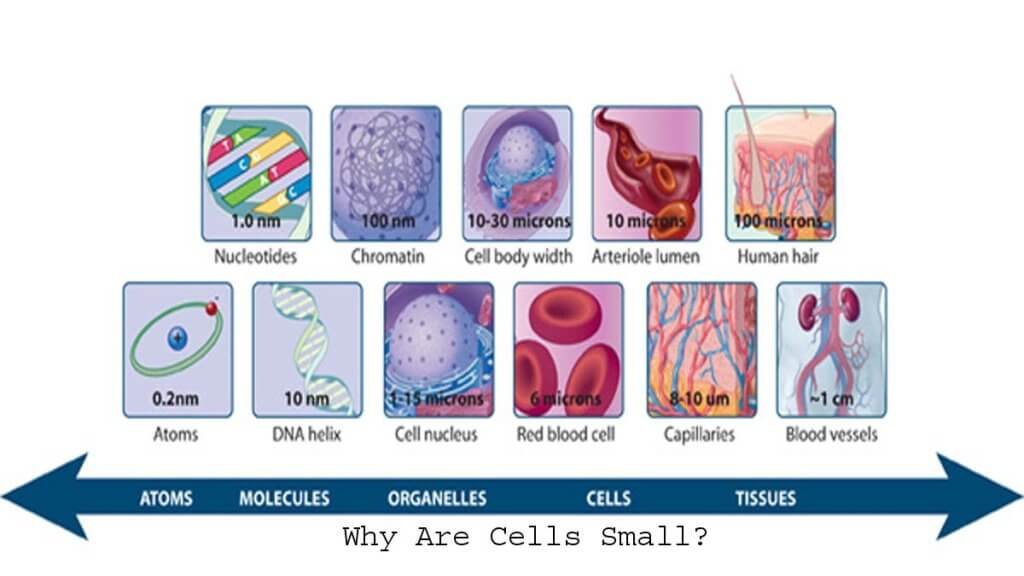Why Are Cells Small! Cells are the fundamental building blocks of life. They come in various shapes and sizes, and each cell is perfectly adapted to carry out specific functions in the body. One striking characteristic of cells is their size, with most cells being microscopic in nature. Have you ever wondered why cells are small? In this article, Why Are Cells Small we will explore the reasons behind this fascinating aspect of cellular biology.
Table of Contents
The Cell’s Structure
Before we delve into why cells are small, it’s essential to understand the basic structure of a cell. A typical cell is composed of three main parts: the cell membrane, cytoplasm, and organelles.
The Cell Membrane
The cell membrane serves as the outer boundary of the cell, controlling the passage of substances in and out of the cell. It plays a vital role in maintaining the cell’s internal environment and providing structural support.
Cytoplasm
The cytoplasm is a gel-like substance that fills the cell, suspending the organelles. It is the site of various cellular activities and serves as a medium for nutrient transport.
Organelles
Organelles are specialized structures within the cell, each responsible for specific functions. They include the nucleus, mitochondria, endoplasmic reticulum, and more.
Surface Area to Volume Ratio
One of the primary reasons why cells are small lies in the relationship between their surface area and volume, often referred to as the surface area to volume ratio.
Understanding the Concept
As cells grow larger, their volume increases more rapidly than their surface area. This means that smaller cells have a larger surface area relative to their volume compared to larger cells.
Impact on Cells
A high surface area to volume ratio is essential for efficient nutrient exchange and waste removal. Smaller cells can quickly absorb nutrients and eliminate waste products due to their larger surface area, promoting better cell health and function.
Efficient Nutrient Exchange
Cells require a constant supply of nutrients and oxygen to carry out their metabolic processes. The small size of cells allows for rapid diffusion of essential substances from the surroundings into the cell’s interior.
Facilitating Cellular Communication
Cells communicate with one another through various chemical signals. Smaller cells enable faster and more efficient communication, contributing to better coordination and functioning within the organism.
Cellular Reproduction and Division
Cell division is a crucial process for growth, repair, and reproduction of organisms. The size of cells plays a significant role in these processes.
Mitosis
During mitosis, a single cell divides into two identical daughter cells. Smaller cells can undergo mitosis more effectively, ensuring a continuous supply of new cells for tissue growth and regeneration.
Meiosis
Meiosis is a specialized form of cell division that produces gametes (sex cells). Smaller cells ensure genetic diversity and successful fertilization during sexual reproduction.
Energy Efficiency
Smaller cells have higher energy efficiency. This is because they have a lower demand for resources, allowing them to thrive with minimal energy requirements.
Limits to Cell Size
While small cell size offers numerous advantages, there are limitations to how small a cell can be.
Metabolic Requirements
Cells must contain all the necessary cellular machinery to function independently. At a certain point, cells become too small to house these essential components.
Diffusion Limitation
Cell size also affects the rate at which substances can diffuse within the cell. Extremely small cells may face challenges in transporting molecules across their membrane effectively.
Cellular Specialization and Differentiation
Cell size can vary depending on the cell’s specific function. Specialized cells, such as nerve cells and muscle cells, may be larger to accommodate their unique roles in the body.

Conclusion
In conclusionof Why Are Cells Small, the small size of cells is not a coincidence but rather a well-adapted feature that ensures their efficient functioning within organisms. The surface area to volume ratio, efficient nutrient exchange, cellular communication, and reproductive processes all benefit from the small size of cells. However, there are limits to how small cells can be due to metabolic requirements and diffusion limitations. Cellular specialization also plays a role in determining cell size based on specific functions.
FAQs About Why Are Cells Small?
Can cells be larger in some organisms?
Yes, certain organisms, such as certain algae and eggs of some animals, can have relatively larger cells.
How do larger cells handle nutrient exchange?
Larger cells may develop specialized structures or adaptations to facilitate nutrient exchange efficiently.
Are all cells the same size in an organism?
No, cells can vary in size depending on their function and location within the organism.
Can cell size change over time?
Yes, certain cells, like muscle cells, can increase in size with exercise and training.
What happens if a cell becomes too large?
When a cell becomes too large, it may struggle to meet its metabolic demands and may undergo cell division or face functional issues.
